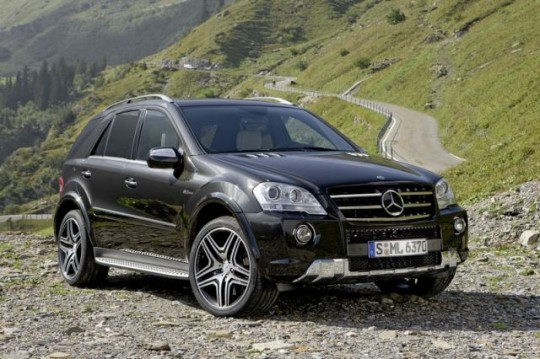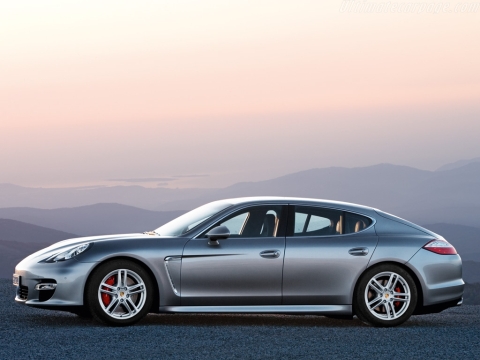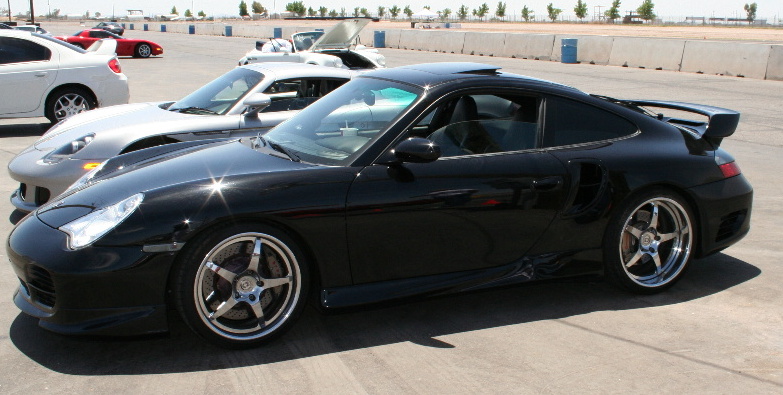
Porsche's got a lot on the Cayenne line, and having had a look at the new Hybrid and Turbo variants we don't believe they have anything to worry about. The Hybrid is the first from the automaker, but will be just one of five Cayenne trims on offer, and gets you 23-percent better mileage for what is sure to be a hefty premium. Overall system horsepower is 380 horsepower, yet often times you won't even notice it because you'll be "sailing," which is when the drivetrain is decoupled from the engine and happens at speeds up to 97 mph.
Even More Dynamic, Even More Efficient – and for the First Time also with Hybrid Drive
New Porsche Cayenne with Fuel Consumption down by up to 23 per cent
Even more sporting and dynamic, even more fuel-efficient, even more spacious and lighter, pointing into the future of technology and robust in its classic characteristics – the new Cayenne is more of a Porsche than ever before. Led by the Cayenne S Hybrid, the first Porsche with hybrid drive, the new generation of the Cayenne sets the standard in its class in terms of efficiency and performance.
Compared with the former models fuel consumption, for example, is down by up to 23 per cent. Quite simply because the new Cayenne, like every Porsche, has been developed according to the principle of Porsche Intelligent Performance: More power on less fuel, more efficiency and lower CO2 emissions.
The Cayenne is making its European debut on 8 May in no less than five different versions – so that right from the start Porsche offers each and every customer exactly the right model for his personal taste and requirements. The highlight of this change in generations is the world debut of the highly efficient Cayenne S Hybrid consuming a mere 8.2 litres/100 kilometres, equal to 34.4 mpg imp. At the same time the combination of a 333-bhp three-litre supercharged V6 and a 34 kW (47 bhp) synchronous electric motor offers all the performance of an eight-cylinder, with overall system output of 380 bhp (279 kW).
The entry-level model is the 3.6-litre V6 Cayenne. Despite engine output now raised to 300 bhp, fuel consumption in the New European Driving Cycle in combination with optional eight-speed Tiptronic S is down versus the former model by 20 per cent to 9.9 ltr/100 km, equal to 28.5 mpg imp. The Cayenne Diesel*, in turn, with its three-litre V6 delivering maximum output of 240 bhp (176 kW) and peak torque of 550 Newton-metres (406 lb-ft), likewise consumes 20 per cent less fuel than before, in this case 7.4 instead of the former 9.3 ltr/100 km, equal to an improvement from 30.4 to 38.2 mpg imp.
The high-torque Cayenne S with its 4.8-litre V8 likewise shows a significant decrease in fuel consumption, down in this case by 23 per cent to 10.5 litres/100 kilometres, equal to 26.9 mpg imp.
* Cayenne Diesel not available in the USA, Canada, Japan and China.
At the same time engine output is now 400 bhp versus the former 385 bhp, the Cayenne S thus offering a significant improvement in performance, like all models in the new generation.
The same applies to the Cayenne Turbo, with its 4.8-litre V8 biturbo delivering maximum output of 500 bhp (368 kW) and now consuming just 11.5 ltr/100 km (equal to 27.6 mpg imp) in the New European Driving Cycle, again 23 per cent less than the former model (14.9 ltr/ 100 km, equal to 19.0 mpg imp).
This reduction in fuel consumption is attributable, among other things, to the introduction of Porsche's new eight-speed Tiptronic S with Auto Start Stop and the wide spread of gear increments, thermal management on the engine and the transmission cooling, on-board network recuperation, variable engine cut-off in overrun and, not least, intelligent lightweight construction.
Thanks to the combination of materials minimised in weight and changes in the concept of the overall vehicle such as the new, active and extra-light all-wheel drive, overall weight of the Cayenne S, for example, is down by a substantial 180 kg or 397 lb, despite the improvement in product substance and an even higher standard of safety. This has positive results not just in terms of fuel consumption and CO2 emissions, but also when it comes to performance, agility and handling.
Together with the Cayenne S Hybrid, no less than three of the five Cayenne models consume less than ten litres of fuel per 100 kilometres in the New European Driving Cycle, with two models emitting less than 200 grams of CO2 per kilometre. At 193 g/km, the Cayenne S Hybrid is not only the cleanest Cayenne in terms of CO2 emissions, but rather the cleanest model throughout Porsche's entire portfolio.
Porsche Parallel Full Hybrid making its world debut
The Cayenne S Hybrid is Porsche's first production model with hybrid drive. Through its intelligent interaction of a three-litre supercharged V6 power unit and the electric motor, the Cayenne S Hybrid focuses on maximum efficiency from the vehicle's overall driving system. Depending on driving conditions, this is achieved, as the case may be, by only one of the drive systems operating alone, or by both units running at the same time.
In either case, the 34 kW (47 bhp) electric motor is the ideal partner for the 333 bhp supercharged engine with its high torque at low speeds. Together, the two drive units develop maximum system output of 380 bhp and peak torque of 580 Nm/427 lb-ft at just 1,000 rpm, which means the same kind of performance as the Cayenne S with its V8 power unit.
The two drive units are connected to one another by a separator clutch master-minded by the Hybrid Manager. This separator clutch ensures that the Cayenne S Hybrid may be driven either by the electric motor or the combustion engine alone, or by both drive units together. This means that when driving in a more reserved, moderate style – for example in a residential area – the Cayenne S Hybrid may run for a couple of kilometres entirely on electrical power, without any emissions and with minimum noise, even reaching a speed of 60 km/h or close to 40 mph in the process.
To accelerate fast and dynamically, on the other hand, the electric motor provides a boost effect for additional power and traction, intelligent management of the separator clutch keeping the transition between the various hybrid driving modes smooth, comfortable and quick, again to the benefit of the driver.
The hybrid system incorporates a 288 volt nickel metal-hydride battery (NiMh) fitted beneath the luggage compartment, storing electrical energy regained when applying the brakes and driving under regular conditions. This energy is then available for boosting and electric motoring, again saving fuel in the process.
Additional savings potential by "sailing" up to 156 km/h or 97 mph
Using the separator clutch, Porsche hybrid drive also offers further potentials for enhancing fuel economy at high speeds by "sailing": Whenever the Cayenne S Hybrid does not require drive power, the combustion engine is switched off completely when the driver takes back the gas pedal at speeds of up to 156 km/h or 97 mph and is therefore separated from the drivetrain.
This means a significant reduction of fuel consumption at steady speeds on the autobahn, with engine drag forces and their braking effect being eliminated when sailing, thus helping to reduce driving resistance and, as a result, fuel consumption. Then, as soon as the driver presses down the gas pedal in the sailing mode, for example to overtake another vehicle, the combustion engine starts again absolutely smoothly within fractions of a second, revving up to the current speed of the vehicle. Thanks to the Hybrid Manager, therefore, the Cayenne S Hybrid is able to accelerate dynamically in gears even at such higher speeds, in the same way as a Cayenne with a conventional power unit.
New active all-wheel drive with electronically controlled multiple-plate clutch
Porsche has developed active all-wheel-drive for the new Cayenne driving the rear wheels and transmitting power to the front wheels through an electronically controlled, map-based multiple-plate clutch operating as a function of driving conditions.
The two main reasons for choosing this technology were the reduction of weight and the wish to make the new Cayenne even more agile on the road. But at the same time it almost goes without saying that the Cayenne offers all the offroad qualities required by the customer under normal conditions.
This active all-wheel-drive may be supplemented for the first time on request by Porsche's new PTV Plus: Porsche Torque Vectoring Plus uses variable torque distribution on the rear wheels as well as an electronically controlled rear axle differential lock, thus increasing both driving dynamics and stability in bends.
This new hang-on all-wheel drive is featured on the Cayenne, the Cayenne S and the Cayenne Turbo with their high standard of driving dynamics, while the Cayenne Diesel and the Cayenne S Hybrid come with permanent all-wheel drive incorporating a self-locking centre differential.
Superior suspension with various options for enhanced driving dynamics
Once again Porsche's engineers have succeeded in making the outstanding driving characteristics of the Cayenne significantly better – and again, the name of the game is lightweight engineering, with the chassis alone now 33 kg or 73 lb lighter thanks to the consistent use of aluminium.
All versions of the Cayenne with the exception of the Cayenne Turbo come as standard with steel suspension combined for the first time as an option with Porsche Active Suspension Management (PASM). PASM is a highly sophisticated damper system for active, infinite damper control on the front and rear axle, offering the choice of the three Comfort, Normal, and Sport programs.
The Cayenne Turbo features new air suspension and comes with PASM as standard – a combination also available on request on the other models.
On the Cayenne, the Cayenne S and the Cayenne Turbo air suspension and PASM may be further enhanced as an option by PDCC Porsche Dynamic Chassis Control, an active system stabilising the body of the vehicle through dynamic distribution of roll forces.
Design: elegance in a new dimension
The new generation of the Cayenne sets a clear message in its design: even more sporting, even more dynamic, and definitely Porsche at very first sight. Indeed, the all-new, classy design of the new Cayenne makes the new generation even more clearly a member of Porsche's family of sports cars and the Panamera range.
Despite its larger exterior dimensions, the 2010 version of the Cayenne looks a lot more compact and even more dynamic than before. Its particular character of a sports car comes out even more clearly than before from all angles, together with that very special design and shape so typical of a genuine Porsche.
All new models in the Cayenne range share the new headlight graphics unmistakable in every respect, with the additional high-beam headlights positioned in each case on the inside. The close connection to Porsche's overall model family is further accentuated at the rear by the strong and powerful shoulders of the new model. And last but certainly not least, a striking effect is the rear wings flowing to the back and further enhancing the broad shoulders again so typical of a real Porsche.
Interior: the Cayenne world
The first eye-catcher within the newly designed interior is the centre console rising up to the front with its high-rising gearshift lever, giving the interior the looks of a cockpit at the front end. A further decisive design feature is the grab handles on the centre console typical of Porsche but new in design and now featured on all four doors.
The seats in the new Cayenne have also been upgraded, now offering all passengers even greater comfort and, thanks to the wheelbase extended in length by 40 millimetres or almost 1.6", a lot more room on the rear seats. The entire rear-seat bench, finally, moves to and fro by 160 millimetres or 6.3", and the backrest angle may be adjusted by up to 6°.
Over and above the range of instruments already featured, the new Cayenne comes with a 4.8-inch high-resolution TFT colour display in the instrument cluster offering a wide range of display options covering the various set-ups of the vehicle, audio, telephone, navigation, map presentation, on-board computer, tyre pressure control and cruise control functions.
The instrument cluster in the Cayenne S Hybrid differs from that in the other models through a number of technical details giving the driver a genuine experience of the innovative hybrid drive system, also through the instrumentation used.
As a further special feature, the new Cayenne comes with the latest generation of audio and communication systems carried over from the Panamera, offering not just a BOSE®, but also the Burmester® high-end surround sound system.
New assistance systems, some even featured as standard
Porsche offers a wide range of assistance systems for the new generation of the Cayenne, with the PDLS Porsche Dynamic Light System, for example, making its debut in the new model.
PDLS is a further development of the existing xenon lights system and offers not only dynamic and static bending lights, but also, for the first time in the Cayenne, speed-related headlight control with separate light modes for country roads and the autobahn, as well as bad weather lights. The system is standard in the Cayenne Turbo and comes as an option in the other models.
Yet another new feature is the optional Lane Change Assistant (LCA). This driver assistance system monitors the lanes to the right and left of the vehicle up to 70 metres or 230 feet back, including the driver's blind angle. As soon as another vehicle enters the blind angle or approaches rapidly from behind, an LED warning light will light up on the inside of the appropriate exterior mirror, as of a distance of 55 metres or 180 feet. Should the driver then set the direction indicator, he will be warned of the vehicle approaching from behind by the warning light flashing on and off as a clear signal.
The Cayenne comes as standard with automatic cruise control offering extra comfort on long distances by automatically keeping the speed set by the driver in a range from 30 – 240 km/h (19 – 249 mph).
Automatic cruise control with a distance warning function is available as an option. Using radar sensors, ACC monitors the distance to the vehicle ahead, automatically maintains the distance set in advance and, when necessary, applies the brakes should the distance between the two vehicles become too small – if necessary even slowing down the Cayenne to a halt.
Automatic cruise control operates at speeds from 30 – 210 km/h (19 – 130 mph), the stopping power required, as calculated by the system, being provided by PSM actively building up brake pressure.
To set off again after coming to a halt, all the driver has to do is briefly press the control lever or the gas pedal.
ACC also offers a range of functions for enhanced active safety. Whenever the distance from the vehicle ahead becomes too small, for example, the system alerts the brake standby function to shorten the stopping distance required. It also prefills the brake system for an immediate response and gives the driver both a visual and an acoustic warning in dangerous situations, together with an additional brake pulse again alerting the driver to a possible risk.

















































